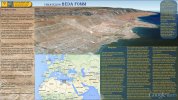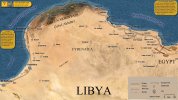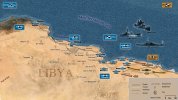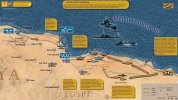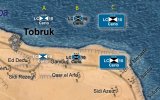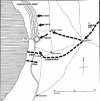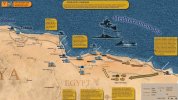Complete....
For example, what do you know about the railway that stops at Masheifa, right in the middle of this area of operations?
Its clearly marked on the Wiki map here:
https://upload.wikimedia.org/wikipedia/commons/6/63/WesternDesertBattle_Area1941_en.svg
I don't think that the railroad line ended at Masheifa (Misheifa?), as some sources (including the wiki source about Churchill's deception "artists") mention that materiel and vehicles were brought right to Fort Capuzzo, and that Masheifa was only used as deception hub. Therefor the creator of the wiki-map seems to have misinterpreted the word "railhead", which can be found in a number of books covering the time frame between the preparation for "Crusader" and the actual operation, as "the farthest point to which the
rails of a railroad have been laid" (dictionary definition).
I'd go for the other definition of the word railhead: "a railroad depot at which supplies are unloaded to be distributed or forwarded by truck or other means."
The Capuzzo station must have been so small and unremarkable, that German aerial units did or could not identify it as important hub.
I compared actual google map images with the map on wiki, and it seems that - nowadays - the tracks lead all around to Sollum (in a really wide bypass turn), in particular to the ridge slighty north to the serpentine road that leads up to the point where the old Sollum barracks must have resided. The modern railroad ends near the historical position of the Sollum Barracks.
Other sources indicate that the railrad had been extended to Capuzzo, and still other sources mention the Capuzzo-Tobruk Railway, where it's not clear when that part had been laid.
As Sollum, residing right at the Sea, and north of the Halfaya Pass, only offered a bottleneck - the serpentine road up that ridge - it's pretty obvious that rails had to bypass that area. I followed the rail tracks from Sollum (in a bypass turn) to the WEST then South, and figured that the modern railroad then goes East to Mersa Matruh, El Alamein and even further East, connecting Alexandria, and Cairo, with one or another branch leading south, connecting military bases here and there, including a military airbase, or (way South of Cairo), connecting industrial quarters.
The modern rail line seems to follow the historical track bed to quite some extent, at least from Masheifa to Mersa Matruh, and also partially (or even fully?) to El Alamein and Alexandria.
On Google maps, on the wide bypass turn around Sollum, you can see that just West and South West of Sollum all defensive positions are still visible, and that there is a junction (if you follow the tracks from Sollum down south-WEST) and that from that point a track bed is branching off and leading north (leading right to the "Gateway Sollum" border post), but with the rails missing. Just East of the border post are WW2 trenches, bomb/shell craters and AT gun positions, right at the post is a huge rock, but the trackbed goes even further - entering Libya, but it's not clear whether it ends slighty left of the (Libyian) "Gateway Emsaed", or if it even went up to the GREEN house south of the town of Musaid, where both points are near the general historical Fort Capuzzo area, if you look at historical military maps.
That said, err .. researched

, the extended railroad line must have led right up to Capuzzo, and it's questionable if Sollum was connected back then. Sollum was too small, and the barracks on the ridge too exposed (air strikes) to justify a depot/station up there, so I am guessing that the Sollum turn was established after the war.
In turn, Libya must have removed the tracks on its territory after the war, as the railroad went right over the border, without the possibility to check trains and freight, as the sat images do not show traces of a (rail-)checkpoint.
ORIGINAL : "Middle East Railways" by Hugh Hughes:

ORIGINAL:
"Directory of Railway Officials & Yearbook", Tothill Press, 1947:

You'd have to buy these books (or check them in a library) to confirm when the military extension of the railroad had been finished.
With the current hints, I'd say Capuzzo was connected in 1941, Sollum probably not, and at one point there was a complete El Alamein - Capuzzo - Tobruk rail line.
In 1943, the rail line was completed, connecting Beirut (Lebanon) with Tripolis ( Libya !!!).
This military map gives another hint, and shows a real railhead (as in "endpoint") at Tobruk:
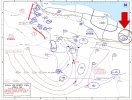
I have marked the hub with a circle. So, the extension to Tobruk existed in May 1942, at least. The wiki section holding the map above states:
"
Although not as much a reason for its strategic significance, the British built a rail line from El Alamein to Tobruk during the course of the war. This rail line was significant both for purposes of supply and as a sense of pride to the Allied troops, as the rail line was built through a little-populated, inhospitable desert."
So, during Operation Crusader, at least the line El Alamein - (fake) Masheifa - Capuzzo must have existed. Somewhere between autumn 1941 and April 1942, the Tobruk-Capuzzo section must have been completed.
Eventually, in 1943, the line went from Alexandria to Tobruk. I am not sure what town of Similla that would be, as "Similla - Tobruk" is being mentioned quite often, and there is a town of Similla north of Cairo, nowadays, but another section explains that Similla's locals/civilians were evacuated in 1942, and I am not sure whether that was necessary in the general Cairo area (even though the British HQ personnel in Cairo had started to burn confidential maps and documents, when the Germans had reached El Alamein).
I think one of these sources below mentioned the evacuation, IIRC, and seemed to suggest that the civilians were evacuated from places in the hub's vicinity for secrecy reasons (so that the germans don't get to know about the major supply point/operations).
The modern Similla resides around 60 km north of Cairo, 111 southeast of Alexiandria, 74 km south of the Al Burj (Burg) harbor area and 131 km west southwest of the deepwater port in Port Said, so it's absolutely possible that supplies were hauled from Port Said and Alexandria to Similla, as that area was somewhat protected/hidden inland, and as that hub could also support Cairo, until Alexandria was connected.
But I am still not sure if that's the right Similla.
http://nzetc.victoria.ac.nz/tm/scholarly/tei-WH2Engr-c9.html :
New Zealand Engineers, Middle East
CHAPTER 9
The Western Desert Railway
"To complete the additional section of the Western Desert Railway Extension in time for the Eighth Army's first offensive, the Construction Group and its Pioneer helpers had worked long hours for seven days a week through the torrid winds and dust of summer into the bleakness of winter.
But their efforts would have gone for nothing without the wonderful efforts of the transportation organisation in Alexandria, which was responsible for the supply, loading and despatch of the large daily requirements for the two miles or so of railway track. Often the material was loaded into wagons straight from the ships' holds and then the Railway Operating units had to fit the trains into a timetable of a very busy single-track line with three greater priorities—food, water, ammunition. The supply train nearly always arrived at track-head at 7 a.m. in spite of enemy interference, the odd hot box or a broken coupling, a tremendous achievement by the Operating Units and fully appreciated by the Construction sappers.
And then, while the Division moved up to and into the battle for the escarpments and ridges south-east of Tobruk, the Group had replaced twisted rails and splintered sleepers resulting from enemy bombing, bombing that did not prevent the Operating Group from running its trains."
http://nzetc.victoria.ac.nz/tm/scholarly/tei-WH2Engr-c14-1.html#name-026613-mention :
A section referring to events in 1942 (afaik):
"
While the water reservoirs at Capuzzo, Misheifa and Similla were being repaired the whole of the running was performed with diesel engines, but a partial changeover to steam loco operation was made on the 28th and three days later (1 December) the diesel-electric locos were worked over the Capuzzo-Tobruk sector, leaving the steam locomotives to operate between Similla and Capuzzo."
http://nzetc.victoria.ac.nz/tm/scholarly/tei-WH2Engr-c14-1.html#name-026613-mention
Railway Operating Group
"In spite of the precautions to ensure that no information leaked out regarding the build-up for the Eighth Army attack in October 1942, the New Zealand Railway Operating Group could not help knowing that something big was afoot. For weeks they had been pushing train loads of stores forward to Burg el Arab by day and by night and they had watched the entertaining sight of army transport evacuating native families and their assorted livestock; opinions were divided as to whether this was a precaution against espionage or merely to reduce the fly nuisance.
A highlight of the period was an attempt by Italian commandos, who were landed from a submarine near Burg el Arab, to blow up the line near Hawaira. The only result was a broken rail and the loss of a few thousand gallons of Nile water, for Gurkha troops soon rounded up these rather amateur demolition experts. The Gurkhas patrolled the area for a week or so but there were no more efforts to dislocate the railway system. The operating sappers manning the stations got along very well with the little smiling men from the mountains of North India. Few could speak much English but the two races met on common ground around a draught-board. The Gurkhas won nearly every game.
It has been related that, on 5 November, 2 NZ Division was concentrated to the south of Fuka. At a minute past midnight on the same date, new railway operating instructions came into force, placing the responsibility for the running of traffic as follows:
‘OC 16 NZ Rly Op Coy—Stations from amriya to hammam. The 16 NZ Rly Op Coy will be responsible for the signalling and despatch of all trains at amriya station. Shunting duties at amriya station and depot will be carried out by 16 NZ Rly Op Coy. Two diesel shunting engines are located at amriya depot.
‘OC 17 NZ Rly Op Coy—Stations hammam to railhead. The 17 NZ Rly Op Coy will be responsible for the signalling and despatch of all trains at hammam station and West thereof. Also for shunting railhead depots.’
Railhead for the moment was at Alamein while Railway Construction Groups worked across the battlefield towards Daba, which became the railhead on the 10th when the first stores train arrived there. The repair gangs had not only to deal with shell and bomb damage but also had to replace sleepers and rails taken from the road bed by both armies for the construction of splinter-proof shelters.
While 2 NZ Division was stacking up at the foot of Halfaya Pass at the Egyptian border (11 November) the construction train was working west of Daba, to which station Major Pearse had shifted 17 Company Headquarters, and from where the Group was operating some American main-line diesel-electric locomotives. The arrival of these was well timed as steam engines were dependent on water and the damage to the water pipelines and reservoirs had not yet been made good. Major Aickin writes:
‘These diesel locos, had been constructed and shipped in such a hurry that there was insufficient time for carrying out the customary service trials. However, although the locomotives were practically nothing more than working blue prints when they reached us, they arrived in the nick of time and served our needs admirably. The NZ engine drivers quickly learned to handle them.’
Railhead was at Matruh on the 13th, when three trains were despatched from Daba to that destination; by the 25th, after relief by 193 Railway Operating Company, RE, 17 Company had manned and was operating from its headquarters at Capuzzo the Misheifa – Capuzzo – Tobruk Road section. On the same day 16 Company, now relieved by 115 (Indian) Railway Operating Company, had settled into its old ‘possie’ at Similla and taken over the Similla–Misheifa section."
These sections are particularly interesting:
- "A changeover to diesel-electric locomotives was completed on 8 March [1943] when WD Locos 9332 and 9327 hauled the last steam-operated service page 399 (Train No. 5) over the Tobruk Road – Capuzzo – Misheifa section. The steam loco depot at Capuzzo closed the same day and coal, oil and wood supplies, together with depot equipment, were despatched to Misheifa. The rail loop at Tobruk docks was finished on 10 March and on the following day a 17 Company diesel crew and brakesman ran the first train over the new extension that finally linked Alexandria with Tobruk. In a way it was a pity that it was not Kiwi construction men who put the finishing touches to the Western Desert Extension."
- "The completed line from Beirut to Tripoli had been opened with some pomp and ceremony by General Alexander on 21 December [1943], and it was now possible, but highly improbable until the war was over, to travel by rail from Cairo to any continental city.
Until that point, supplies were either hauled to El Alamein (and then shipped to Capuzzo, later on Tobruk, by train), or the tracks just went to Cairo and then to Beirut, instead to the port of Alexandria, with El Alamein then serving as main supply hub. I am just guessing here, you'd have to read all that stuff to make sure.

Whatsoever, if the Germans would have put similar efforts into building up a railway supply system (from Tunisia) up to Tobruk or even Capuzzo/Misheifa, their supplies (especially fuel) would not have led a miserable existence in the ports of Tunisia, where they clogged the depots more than often, due to the low number of motor transports bringing supplies to the front. Tank formations sometimes just sat in the desert for 1 or 2 days, until fuel could be brought in. The Italians, with their low number of 700 (at some point, afaik) trucks/transports were even worse off, as their motor pool had to haul supplies for 250,000 troops, before the Germans arrived in force.
